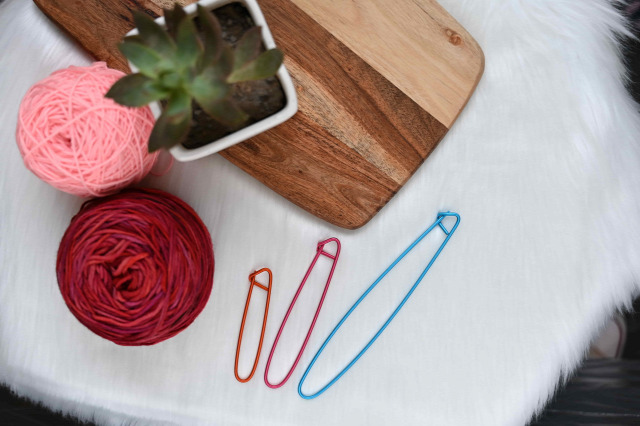Stitch holders are essential crafting accessories that every knitter must own. As the name suggests, they are tools used in knitting and crocheting to hold stitches. These stitches are generally live stitches that need to be removed from the knitting needles or crochet hooks to work on them later. To explain better, for example, you are working on a knitting or crochet pattern, and there comes a step in the pattern that requires you to hold stitches temporarily for later use. Here, you will need assistance with the handy stitch holders.
In projects, whether you knit or crochet, stitch holders come in handy when you need to shape the neckline of a sweater or armholes for garments or prepare for the Kitchener stitch for shoulders or socks. As the live stitches stay secure, you do not have to worry about those unfinished loops and continue with the stitches you have in hand.
Though stitch holders are lifesavers, they aren't hard to use. In this blog, we'll explore stitch holders in detail.
What are Stitch Holders? (H2)
Stitch holders come in many sizes. They look like safety pins and have a snapping end that does not let the stitches drop or come undone.
Small yet mighty crafting accessories are readily available in yarn shop displays or your favorite online stores. When you step into garment making—sweaters, cardigans, or tees—you will work with them more. As the name says, stitch holders hold stitches aside securely for a portion of your project. You'll commonly see pattern directions telling you to use a stitch holder with instructions on how many stitches to hold and when and how to return them to the knitting pattern.
When to Use Stitch Holders? (H2)
Generally, knitting or crochet patterns instruct when to use stitch holders. But, if you are working on your own design, you will need stitch holders anytime you want to secure live stitches that you will work on later. They serve design and functionality.
-
To Shape Armholes and Necklines (H3)
Knitted or crocheted garments such as sweaters, cardigans, or tees have armholes and necklines that are worked separately from the main section. In these situations, stitch holders become lifesavers as you can hold the stitches for the neckline or sleeve openings while working on the body of the garment, seamlessly picking them up later to join the pieces.
-
To work on thumb sections of Gloves and Mittens (H3)
In projects such as gloves and mittens, you work separately on the thumb and finger sections. Stitch holders are handy here, too, to keep your live stitches secure while you complete the rest of the project.
-
Creating Buttonholes (H3)
For knitted or crocheted garments that require functional buttonholes, stitch holders allow you to cast off a specific number of stitches and hold them live, creating a gap for the button to go through.
-
Cable Patterns (H3)
Cables are intricately twisted stitches made with out-of-turn stitches. While knitters reach for cable needles, stitch holders keep the live stitches secure so that they can be worked on later.
Once you have your trusty stitch holders, you can start including them in your knitting and crocheting routine.
Here are some helpful tips:
Go through the Knitting or Crochet Pattern: Read your pattern carefully to understand when and how to use stitch holders and the number of stitches to be held.
Picking Up Stitches: When you need to return the held stitches, knit or crochet them back onto your working needle one at a time. Pay attention to maintaining the correct stitch order, especially when working armholes.
Choosing the Right Size of Stitch Holders: The size of the stitch holders you need depends on how many stitches need to be moved to them and how big they are depending on the yarn (e.g., fingering weight yarn or bulky weight).
Alternatives of Stitch Holders (H2)
If you're stuck on a project and don't have a stitch holder handy, you can accomplish the same task by using some waste yarn, a bit of extra yarn you're not using) or even dental floss to hold onto the stitches. The advantage of stitch holders, though, is the security of holding the stitches and keeping them closed.
If you are working with KnitPro interchangeable circular needles or sets, a cable can manage the task of stitch holders, but you need to secure the stitches with end caps. Another handy help is that KnitPro interchangeable circular knitting needles come with a lifeline hole where you can thread yarn or floss and keep the stitches secure.
Now that you know the fantastic benefits of working with stitch holders, get yourselves the best from KnitPro. Our aluminium stitch holders come in a set of 3 in different sizes in vibrant colors. So, are you ready to enhance your crafting with stitch holders?


